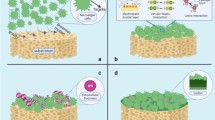Abstract
The activity of immobilized cell-support particle aggregates is influenced by physical and biochemical elements, mass transfer, and physiology. Accordingly, the mathematical model discussed in this study is capable of predicting the steady state and transient concentration profiles of the cell mass and substrate, plus the effects of the substrate and product inhibition in an immobilized cell-support aggregate. The overall mathematical model is comprised of material balance equations for the cell mass, major carbon source, dissolved oxygen, and non-biomass products in a bulk suspension along with a single particle model. A smaller bead size and higher substrate concentration at the surface of the particle, resulted in a higher supply of the substrate into the aggregate and consequently a higher biocatalyst activity.
Similar content being viewed by others
References
Gikas, P. and A. G. Livingston (1997) Specific ATP and specific oxygen uptake rate in immobilized cell aggregates: experimental results and theoretical analysis using a structured model of immobilized cell growth.Biotechnol. Bioeng. 55: 660–673.
Monbouquette, H. G., G. D. Sayles, and D. E. Ollis (1990) Immobilized cell biocatalyst activation and pseudo-steady-state behavior, model and experiment.Biotechnol. Bioeng. 35: 609–629.
Riley, M. R., F. J. Muzzio, and S. C. Reyes (1997) Effect of oxygen limitations on monoclonal antibody production by immobilized hybridoma cells.Biotechnol. Prog. 13: 301–310.
Nakasaki, K., T. Murai, and T. Akiyama (1989) Dynamic modeling of an immobilized cell reactor.Appl. Biochem. Bioeng. 22: 279–288.
Godia, F., C. Casas, and C. Sola (1987) Mathematical modelization of a packed-bed reactor performance with Immobilized yeast for ethanol fermentation.Biotechnol. Bioeng. 30: 836–843.
Berry, F., S. Savadi, M. Nasri, J. N. Barbotin, and D. Thomas (1988) Effect of growing conditions of recombinantE. coli in carrageenan gel beads upon biomass production and plasmid stability.Biotechnol. Lett. 10: 619–624.
Sola, C., C. Casas, M. Poch, and A. Serra (1986) Continuous ethanol production by immobilized yeast cells and ethanol recovery by liquid-liquid extraction.Biotechnol. Bioeng Symp. No 17: 519–533.
du Poet, P. T., P. Dhulster, J. N. Barbotin, and D. Thomas (1986) Plasmid inheritability and biomass production, comparison between free and immobilized cell cultures ofEscherichia coli BZ18(pTG201) without selection pressure.J. Bacteriol. 165: 871–877.
Wang, H., M. Seki, and S. Furusaki (1995) Mathematical model for analysis of mass transfer for immobilized cells in lactic acid fermentation.Biotechnol. Prog. 11: 558–564.
Tsuchiya, K. and T. Kimura (1980) Growth kineties under adenine limiting conditions of KYA 741, and adenine-requiring strain.Biotechnol. Bioeng. 22: 401–410.
Konak, A. R. (1975) An equation for batch bacterial growth.Biotechnol. Bioeng. 17: 271–272.
Tayeb, Y. J. and H. C. Lim (1986) Optimal glucose feed rate for fed-batch penicillin fermentation, an efficient algorithm and computational results.Ann. N. Y. Acad. Sci. 469: 382–403.
Chresand, T. J., B. E. Dale, and S. L. Hanson (1988) A stirred bath technique for diffusivity measurement in cell matrices.Biotechnol. Bioeng. 32: 1029–1036.
Zhao, Y. and G. B. DeLancey (2000) A diffusion model and optimal cell loading for immobilized cell biocatalysts.Biotechnol. Bioeng. 69: 639–647.
Johnson, M. J. (1967) Aerobic microbial growth at low oxygen concentration.J. Bacteriol. 94: 101–108.
Chen, T.-L. and A. E. Humphrey (1988) Estimation of critical particle diameters for optimal respiration of gel entrapped and/or pelletized microbial cells.Biotechnol. Lett. 10: 699–702.
Khang, Y. H., H. Shankar, and F. Senatore (1988) Modelling the effect of oxygen mass transfer on β-lactam antibiotics production by immobilizedcephalosporium acremonium.Biotechnol. Lett. 10: 861–866.
Bajpai, R. K. and M. Reuss (1980) A mechanistic model for penicillin production.J. Chem. Tech. Biotechnol. 30: 332–344.
Davis, M. E. and L. J. Watson (1985) Analysis of a diffusion-limited hollow fiber reactor for the measurement of effective substrate diffusivities.Biotechnol. Bioeng. 27: 182–186.
McGinnis, P.H. Jr (1965) Numerical solution of boundary value nonlinear ordinary differential equations.Chem. Eng. Prog. Symp. Ser. 61: 2–7.
Wen, C. Y (1968) Noncatalytic heterogeneous solid fluid reaction models.Ind. Eng. Chem. 60: 34–54.
Author information
Authors and Affiliations
Corresponding author
Rights and permissions
About this article
Cite this article
Moon, SH., Lee, K.B. & Paruekar, S.J. Rigorous model for spherical cell-support aggregate. Biotechnol. Bioprocess Eng. 6, 42–50 (2001). https://doi.org/10.1007/BF02942249
Received:
Accepted:
Issue Date:
DOI: https://doi.org/10.1007/BF02942249




